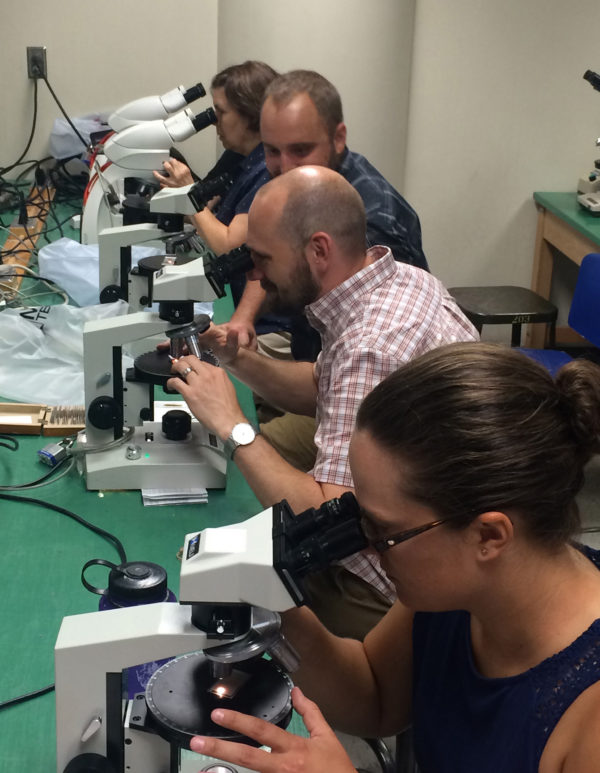
Advancing the Field: Desert Archaeology and the American Ceramic Petrography Workshop
Resident ceramic petrographer Dr. Mary Ownby returns to the blog this week to report on a recent petrography workshop co-sponsored by Desert Archaeology.
My April 7 blog post, Petrography and Archaeology: Microscopic Fun with Pottery, introduced the field of ceramic petrography and how it has been employed at Desert Archaeology for almost 40 years. This branch of study has been around for much longer than that, though—in fact, the geological concepts of petrographic analysis were first applied to archaeological ceramics in the early twentieth century, both in Europe and the US Southwest. Since then the field has both grown and waned (mostly due to fluctuating interest in chemical methods such as neutron activation analysis and X-ray fluorescence spectrometry to study technology and provenance), but petrography has continued to contribute significantly to archaeology.
In order to further the development of the field and provide support for new practitioners, a workshop on ceramic petrography was held at the University of Arizona (UA) from June 26th to 28th, 2017. This workshop was sponsored by Desert Archaeology, Inc., along with the UA School of Anthropology, the UA School of Geosciences, the Arizona State Museum (ASM), Spectrum Petrographics, and Quality Thin Sections.
The workshop brought together 17 ceramic petrographers, ranging from individuals who are well-established in the field to graduate students just learning the technique.

Participants in the 2017 American Ceramic Petrography Workshop (back: Will Gilstrap, Trevor Duke, Matt Pailes, Dave Killick, Daniel Ionico; middle: John Lawrence, Ann Cordell, Mary Ownby, Judith Habicht-Mauche; front: Jennifer Meanwell, Danielle Huerta, Krista Eschbach, Andrea Torvinen, Yukiko Tonoike, Isabelle Druc, Suzanne Eckert; not pictured: Zachary Gilmore).
We focused on a small group to facilitate microscope work and limited the presentations to four: ( 1) Fun with Sand: Petrofacies Development and Approaches to Sourcing (by Mary Ownby, Desert Archaeology, Inc./UA); (2) ‘Total petrography’—the many uses of polished thin sections (by David Killick, UA); (3) Teaching Ceramic Petrography: A Tried and True Model Used at CMRAE (by Jennifer Meanwell and Will Gilstrap of MIT); and (4) This or That or Maybe Both? A synthesis of ceramic petrographic thin section preparation and analysis (by Suzanne Eckert, ASM). The remaining participants presented posters on projects ranging from pottery provenance in Florida to raw materials selection in Peru and glaze technology in New Mexico.
Each afternoon we all gathered in the microscope laboratory to look at each other’s thin sections and discuss the wonders of ceramic technology (i.e., clay balls in sherds—what do they mean?!?). The focus in these sessions was mostly on assisting each other in the identification of unusual mineral and rock inclusions, as well as discussing the types of raw materials used to make ancient pottery. We also had a lovely tour of the ASM pottery vault and a catered reception at the museum.

Workshop participants examining thin sections in the lab (from back to front: Ann Cordell, Trevor Duke, Zachary Gilmore, and Andrea Torvinen).
On the final day, we had a special presentation on the QEMSCAN (Quantitative Evaluation of Minerals by SCANning electron microscopy) instrument by Isabel Barton and how this new technique can identify minerals in samples, but still requires significant user involvement for correct identification. Finally, we had a fruitful discussion on developing a website for the Ceramic Petrographers in the Americas group along with a Facebook page and a listserv. We hope many other petrographers will join to provide support and visibility to our field. We will continue to have sessions at archaeological meetings and hopefully a few more workshops. Overall, it was a wonderful meeting with many new friends made!
Resources
The workshop paper and poster abstracts are available as a PDF.


